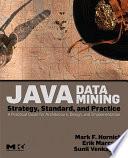
Statistical Data Mining Using SAS Applications, Second Edition
Statistical Data Mining Using SAS Applications, Second Edition describes statistical data mining concepts and demonstrates the features of user-friendly data mining SAS tools. Integrating the statistical and graphical analysis tools available in SAS systems, the book provides complete statistical data mining solutions without writing SAS program codes or using the point-and-click approach. Each chapter emphasizes step-by-step instructions for using SAS macros and interpreting the results. Compiled data mining SAS macro files are available for download on the author’s website. By following the step-by-step instructions and downloading the SAS macros, analysts can perform complete data mining analysis fast and effectively. New to the Second Edition—General Features Access to SAS macros directly from desktop Compatible with SAS version 9, SAS Enterprise Guide, and SAS Learning Edition Reorganization of all help files to an appendix Ability to create publication quality graphics Macro-call error check New Features in These SAS-Specific Macro Applications Converting PC data files to SAS data (EXLSAS2 macro) Randomly splitting data (RANSPLIT2) Frequency analysis (FREQ2) Univariate analysis (UNIVAR2) PCA and factor analysis (FACTOR2) Multiple linear regressions (REGDIAG2) Logistic regression (LOGIST2) CHAID analysis (CHAID2) Requiring no experience with SAS programming, this resource supplies instructions and tools for quickly performing exploratory statistical methods, regression analysis, logistic regression multivariate methods, and classification analysis. It presents an accessible, SAS macro-oriented approach while offering comprehensive data mining solutions.
- ISBN 13 : 1439810761
- ISBN 10 : 9781439810767
- Judul : Statistical Data Mining Using SAS Applications, Second Edition
- Pengarang : George Fernandez,
- Kategori : Business & Economics
- Penerbit : CRC Press
- Bahasa : en
- Tahun : 2010
- Halaman : 477
- Halaman : 477
- Google Book : https://play.google.com/store/books/details?id=hWnMBQAAQBAJ&source=gbs_api
-
Ketersediaan :
Data mining, or knowledge discovery in databases (KDD), is a powerful
information technology tool with great potential for extracting previously unknown
and potentially useful information from large databases. Data mining automates
the ...









